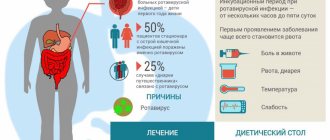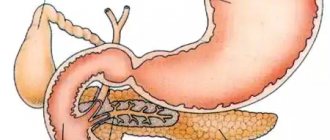Symptoms of pancreatitis and treatment regimen at home
Pancreatitis is the name of a whole group of diseases and symptoms in which inflammation of the pancreas occurs. If such a process occurs, then the enzymes produced by the pancreas do not enter the duodenum. Consequently, they begin to actively act already in the pancreas, gradually destroying it.
Thus, the so-called process of self-digestion occurs. This pathology is fraught with subsequent damage to other organs, because with the gradual destruction of the pancreas, toxins and enzymes are released. In turn, they can end up in the bloodstream and damage other organs. Therefore, acute pancreatitis must be treated immediately after diagnosis. For this condition, treatment is carried out mainly in a hospital.
Causes
The main causes of acute pancreatitis:
- Genetic predisposition.
- Alcoholism and alcohol abuse (70% of cases).
- Cholelithiasis.
- Autoimmune problems (when the immune system attacks its own cells)
- Parasites such as roundworms can also cause blockage in the pancreas.
- Blockage of the pancreatic duct or common bile duct, such as a gallstone.
- Damage to the ducts and pancreas during surgery.
- Complications of cystic fibrosis.
- Kawasaki disease.
- Reye's syndrome.
- Hemolytic uremic syndrome.
- Hyperparathyroidism.
- High content of fats in the blood - triglycerides (hypertriglyceridemia).
- Poor blood circulation of the pancreas.
- Trauma to the pancreas as a result of an accident.
- Viral infections, including mumps, mycoplasma, pneumonia, and campylobacter, hepatitis C.
- Diseases of the duodenum, small and large intestines, accompanied by constipation, such as peptic ulcer, enteritis, colitis, enterocolitis, diverticula.
- Use of certain medications (especially estrogens, corticosteroids, thiazide diuretics, and azathioprine).
Chronic pancreatitis often develops in people who are between 30 and 40 years of age and is most often caused by alcohol abuse over many years, with men predominating over women. Repeated episodes of acute pancreatitis can lead to chronic pancreatitis. In some cases, genetics may be a factor in its development. In 10-15 cases of chronic pancreatitis, the cause is unknown.
Other factors that are also associated with chronic pancreatitis:
- Autoimmune problems;
- Use of estrogens, corticosteroids, thiazide diuretics, and azathioprine;
- Blockage of the pancreatic duct or common bile duct;
- Hypercalcemia - high levels of calcium in the blood;
- Hyperlipidemia or hypertriglyceridemia - high levels of fats in the blood;
- Metabolic disorders, especially fats, associated with overeating;
- Complications of cystic fibrosis, the most common hereditary disorder, when the secretions secreted by various organs are too viscous and thick.
Due to chronic inflammation, scarring occurs on the pancreas, and the organ becomes unable to produce the required amount of digestive enzymes. As a result, the body may be unable to digest fat and other important food components. Damage to the part of the pancreas that produces insulin can lead to diabetes.
Reasons for the development of the disease
We list the common causes that contribute to the occurrence of the disease:
- Heredity: often the disease is passed on from generation to generation.
- Repeated viral or bacterial infections contribute to atrophy of the nasal mucosa.
- Hormonal imbalances, such as endocrine system disorders, that occur in a teenager's body during puberty.
- Trauma and surgery.
- Lack of vitamin D and iron in the body.
- Impact of stress factors.
- Harmful environmental conditions:
- tobacco smoke,
- chemical vapors
- dust and smoke in the air,
- prolonged inhalation of hot or cold air.
Long-term use of vasoconstrictor drops can also cause atrophic rhinitis.
It should be noted that identifying a specific cause that provoked the disease increases the effectiveness of treatment.
Symptoms of pancreatitis
Pain in acute pancreatitis (inflammation of the pancreas) is considered one of the most severe. A sharp, acute pain occurs in the abdomen, in the hypochondrium, in most cases radiating to the area of the shoulder blades, back or behind the sternum.
The main symptoms of acute pancreatitis in adults are listed below:
- Painful sensations in the right or left hypochondrium, shingles are also possible, depending on the degree of the inflammatory process and the area of damage to the pancreas;
- Changes in skin color: sallow complexion, bluish spots around the navel and on the lower back, obstructive jaundice due to sclerosing pancreatitis;
- Deterioration in general well-being, a significant increase in body temperature, weakness, malaise, changes in blood pressure upward or downward;
- A feeling of dry mouth, prolonged hiccups, belching of rotten eggs, nausea and repeated vomiting, which does not bring relief to the patient;
- Stool disorders such as constipation or diarrhea;
- Shortness of breath, increased sweating.
Chronic pancreatitis has a non-aggressive course, accompanied by a decrease in appetite and body weight. The main symptoms of chronic pancreatitis:
- Pain syndrome - this type is characterized by fighting symptoms, usually after eating or drinking alcohol; the unpleasant sensations are constant in the upper half of the abdomen.
- Asymptomatic (latent stage) - the disease can last for years, slowly destroying the pancreas, the patient feels almost no discomfort or it all comes down to simple discomfort, which is given by various simple reasons, such as overeating.
- Pseudotumor type - rare, with all symptoms similar to cancer. Signs of pancreatic cancer are yellowness of the body and sclera of the eye. The head of the pancreas is affected. It increases in size due to its replacement with fibrous tissue.
- Dyspeptic is expressed by intestinal disorder (dyspepsia), diarrhea or constipation, bloating, causeless weight loss.
Quite often, chronic pancreatitis contributes to the development of diabetes. The manifestation of symptoms is influenced by the stage of the disease, as well as whether the patient has undergone treatment, compliance with food intake instructions, the patient’s age and his general physical condition.
What is atrophic rhinitis?
Atrophic rhinitis is a long-term inflammatory disease of the nasal mucosa, accompanied by its thinning. Main signs of the disease:
- increased dryness of the nasopharynx,
- viscous discharge of yellow or green color,
- the appearance of specific crusts,
- short-term bleeding.
Over time, most of the structure of the nose is affected: nerve endings, blood vessels, bone tissue. The disease affects adults, mainly women, and children, most often teenagers. However, sometimes atrophic rhinitis is detected in a child in early childhood (from 1 year).
An alternative name for chronic atrophic rhinitis is “dry” runny nose. This is explained by scanty secretions with severe breathing problems.
The disease is divided into two types:
- Primary.
It forms independently; the causes have not been identified to date. - Secondary.
Appears as a consequence of concomitant pathologies or surgical interventions.
Timely detection and subsequent treatment of atrophic rhinitis is extremely important because the disease quickly becomes chronic. If the mucous membranes do not perform protective and thermoregulatory functions, the functioning of most respiratory organs will be disrupted.
Objective symptoms
Pancreatitis has its own objective symptoms:
- Mussi-Georgievsky's symptom - positive phrenicus - symptom on the left.
- Gubergrits-Skulsky symptom - palpation is painful along the line connecting the head and tail.
- Grotta's symptom - to the left of the navel in the projection of the pancreas, hypotrophic changes in the subcutaneous fat are determined.
- Desjardins' symptom - pain on palpation is determined at the pancreatic point of Desjardins (projection of the head of the pancreas), located 4-6 cm from the navel along the line connecting the right axilla to the navel.
- Tuzhilin's symptom - when examined on the skin of a patient with chronic pancreatitis, hemorrhagic rashes in the form of purple droplets up to 1-4 mm in size can be seen. These are pinpoint angiomas that occur as a result of proteolysis, a destructive effect on the capillaries of pancreatic enzymes released into the blood during an exacerbation of the process.
- Mayo-Robson symptom - pain is determined at the Mayo-Robson point, the projection of the tail of the pancreas, at the border of the middle and outer third of a line segment drawn through the navel, the left costal arch and the axillary region on the left. In this case, pain can be detected in the Mayo-Robson area, the left costovertebral angle.
- Shoffard's symptom - pain is detected in the Shoffard's area (projection of the head of the pancreas), located 5-6 cm above the navel on the right side between the bisector of the umbilical angle and the midline of the body.
- Kach's symptom is a symptom of pancreatitis, in which palpation is painful in the projection of the transverse processes of the right T1X-TX1 and left TVIII-TIX thoracic vertebrae.
- Voskresensky's symptom - in the projection of the pancreas the pulsation of the abdominal aorta is not detected.
Diagnostics
To identify the development of chronic pancreatitis, you must consult a gastroenterologist. An examination is carried out, complaints are collected, and the medical history is analyzed. Based on this, diagnostic procedures are prescribed:
- taking tests to determine the level of blood amylase and urine diastase;
- biochemistry and general blood test;
- general urine analysis;
- Ultrasound of the pancreas is one of the leading research methods that can help determine whether there are pathological changes in the pancreas;
- gastroscopy;
- radiography of the abdominal organs;
- functional tests;
- endoscopic retrograde cholangiopancreatography.
When symptoms of acute pancreatitis appear, urgent hospitalization of the patient and examination and treatment in a hospital are necessary. The main task: to stabilize the patient’s condition, relieve acute symptoms and exclude the possibility of developing pancreatic necrosis.
How to help yourself with pancreatitis
A crisis of pancreatitis is accompanied by severe pain . To reduce them, you need to apply a heating pad with cold water to your stomach in the place where the pain is the strongest. As a result, the frequency and severity of pain will decrease, and the inflammatory process will decrease. Lying down in a horizontal position is prohibited; the best option is the fetal position.
A prerequisite is an examination by a doctor. treat yourself on your own ; this is fraught with exacerbations. Pancreatitis does not go away on its own, and the symptoms mentioned above may also indicate other diseases. If pancreatitis starts, treatment in adults can take a lot of time and money. Children are also diagnosed with this disease.
Surgeons, therapists, and gastroenterologists treat pancreatitis To correctly diagnose a person and establish the form of the disease, a number of examinations are carried out:
- clinical blood tests;
- feces and urine are examined;
- MRI, radiography and ultrasound of the abdominal cavity are performed;
- CT scan (if indicated).
These studies are identical for acute and chronic pancreatitis . The difference is that for the accuracy of the chronic picture, tests are taken during the period of exacerbation .
Treatment of acute pancreatitis
In case of acute pancreatitis, treatment should be carried out in a hospital setting and under the close supervision of specialists, since this condition of the body is considered dangerous. If acute pancreatitis is suspected, a person should be hospitalized as soon as possible.
If an attack of pancreatitis catches you at home, the following actions are recommended before the ambulance arrives:
- The patient should be in bed and completely at rest. This will reduce blood flow to the diseased organ, and therefore reduce inflammation.
- Cold is applied to the epigastric area - this reduces the intensity of pain and slightly reduces swelling and inflammation. It is best if you use a heating pad filled with cold water instead of ice.
- It is forbidden to eat any food. Moreover, you should abstain from food for 3 days. This must be done to stop the production of enzymes that increase the inflammatory response and pain. You can drink water without gas and additives.
- Approved drugs for self-administration are Drotaverine, Spazmalgon, No-shpa and Maxigan. You can drink them before the ambulance arrives. Meanwhile, it is necessary to call doctors even if the patient is not sure that he is having an attack of acute pancreatitis. After all, this pathology is dangerous because it can subside for some time and then rapidly recur.
- With the rapid development of the disease, surgical treatment of pancreatitis is used: removal of part of the pancreas, peritoneal lavage (washing of the abdominal cavity), etc.
The three main words in treating a patient with acute pancreatitis are Peace, cold and hunger. These are the rules of first aid during an attack.
After fasting days, diet No. 5p according to Pevzner is prescribed for a week. Fractional meals up to 8 times a day, in portions of no more than 300g. Boiled, steamed, semi-liquid, pureed food. Food temperature – 20-52˚С. The daily amount of proteins is 80g, fats are 60g, carbohydrates are 280g.
Recommended: slimy porridge with water, crackers soaked in tea, mashed potatoes, pumpkin, zucchini, carrots, jelly, puddings.
All other products and processing options are excluded.
After achieving positive dynamics and pain relief, an extended version of the diet is prescribed for three months. Daily amount of nutrients: up to 120g protein, 70g fat, up to 400g carbohydrates.
Recommended: lean meats and fish, poultry, up to two eggs per day, sour cream, cottage cheese, water porridge, vegetables, jelly and fruit compotes, tea, rosehip decoction, butter in the form of additives in ready-made dishes up to 20g per day, vegetable oil – up to 15g per day.
All of these products must be steamed, baked or boiled.
Treatment of chronic pancreatitis
Chronic pancreatitis can have severe or mild symptoms. Most often, during an exacerbation of chronic pancreatitis, the patient is indicated for hospitalization and therapy similar to the acute process.
The patient must follow a diet throughout his life and take drugs from the group of antispasmodics and drugs that normalize the secretory function of the organ. It is especially useful to undergo sanatorium treatment twice a year in the appropriate institutions of the Stavropol Territory (Kislovodsk, Zheleznovodsk, Pyatigorsk), where treatment is carried out using natural mineral waters.
Diet
If the exacerbation of chronic pancreatitis is quite serious and is accompanied by severe pain, persistent vomiting, and significant changes in laboratory tests, then patients need to starve. Its duration depends on the specific clinical case, but most often ranges from 1 to 3 days. Sometimes during the “hungry” phase it is allowed to drink rosehip decoction, alkaline mineral waters, and weak tea.
Then a special low-calorie diet (up to 2200 kcal) with a normal protein quota is prescribed. It is designed to spare the pancreas and other digestive organs as much as possible.
The features of this diet for pancreatitis are:
- ban on fatty foods (lamb, pork, cream, lard, etc.) and alcohol;
- fractional consumption of food (up to 6 times);
- salt restriction;
- dishes are served exclusively warm;
- chopping or mashing used products;
- widespread use of slimy cereal soups, vegetable puree soups with added boiled meat, soufflés, protein omelettes, fish and meat dumplings, steamed cutlets, meatballs, baked apples, vegetable purees, jellies, mousses, dried white bread, low-fat cottage cheese, jelly;
- exclusion of all products with a high content of extractives or essential oils (fish, meat broths, cocoa, coffee, etc.), fresh berries, vegetables, herbs, fruits, sour juices, carbonated drinks, marinades.
Subject to clinical and laboratory improvement, nutrition is expanded, increasing its calorie content and the amount of proteins needed for a speedy recovery. Although the set of acceptable foods is very similar to the already mentioned diet, the list of dishes on the menu increases (baking is allowed). If pancreatitis is accompanied by the development of diabetes, then white cereals, potatoes, honey, sweets, and baked goods are added to the forbidden food list.
Drug treatment
When following a diet, pain is much less likely to make itself felt, but if you move away from it a little, allow yourself fatty or fried foods, and that’s it - you need painkillers.
- In case of intense pain, the doctor may prescribe antispasmodics - No-Shpa, Drotaverine, which reduce inflammation in the pancreas and accordingly reduce pain.
- Today, the doctor can also prescribe mebeverine (Duspatalin, Sparex) - an antispasmodic, myotropic action, eliminates gastrointestinal spasms.
- You can prescribe antisecretory drugs for a short course (omeprazole or Diacarb, a tablet for three days under the cover of asparkam for edematous form).
- Octreotide, a drug that suppresses the production of hormones by the gland, is also used because they stimulate it and thereby cause pain. This medicine is prescribed only in hospitals.
With a long course of chronic pancreatitis, normal cells of the organ are replaced by connective tissue. Thus, the functionality of the organ is impaired, diabetes mellitus and digestive disorders may develop. In order to reduce pain and give rest to the pancreas, you should take pancreatic enzymes:
- Festal - it should be taken 3 times a day, 1 tablet with meals, it is usually combined with histamine blockers to reduce acidity in the stomach - famotidine, cimetidine.
- “Pancreatin” (“Enzistal”, “Gastenorm”, “Biozim”, “Mezim”, “Mikrazim”, “Pangrol”, “Panzinorm”, “Penzital”, “Creon”, “Ermital”) are pancreatic enzymes, which should be taken like Festal, but it is best to take the drug with alkaline mineral water. They promote better breakdown of proteins, carbohydrates and fats.
- Speaking about enzymes, we must remember about their activity; 10,000 units for lipase (Mezim-Forte tablet) three times a day is the standard requirement for replacement therapy. The original mezim does not have a very pleasant smell; if there is no smell, it is a fake (crushed chalk).
In the presence of chronic pancreatitis, symptoms can persist for a very long time, and insulin levels decrease accordingly, which can ultimately lead to the development of diabetes mellitus. If this pathology is diagnosed, the patient should contact an endocrinologist to develop a treatment regimen and coordinate a diet.
Possible complications of the disease
Prolonged ignoring of pathology leads to serious complications:
- anosmia - partial or complete loss of smell;
- decreased local immunity;
- inflammation of the trachea, larynx, ears, eyeballs;
- deterioration of memory and intelligence;
- hearing problems;
- nasal deformity;
- pneumonia;
- meningitis;
- gastrointestinal dysfunction: nausea, vomiting, dyspepsia, gastritis;
- depressive states, apathy, neurasthenia.
The most difficult consequence of pathology is the spread of the atrophic process to other organs.
Unfortunately, people often turn to an otolaryngologist with an already advanced form of atrophic dry rhinitis. The doctor prescribes treatment that can make the patient feel better and stop the development of the pathology, but it is no longer possible to return the nasal cavity to a completely healthy state.
If you find at least one symptom of a disorder of the mucous membrane, then you need to contact a qualified specialist. This will allow you to diagnose the disease in time and take the necessary measures to treat it.
Folk remedies
The following traditional medicines are used to treat pancreatitis:
- Collection of herbs. To prepare the collection, take string, cudweed, horsetail, chamomile and calendula flowers, St. John's wort, wormwood and sage in equal quantities. The herbs are mixed and crushed. Then prepare an infusion (take a tablespoon of the collection per glass of boiling water, infuse for an hour, strain). The infusion is consumed three times a day, half a glass, half an hour before meals.
- Two leaves of golden mustache are poured into 0.5 liters of boiling water, placed on low heat and boiled for 15 minutes. Then cool the mixture for 8 hours. Before use, the infusion is heated to a warm state in a water bath and drunk before meals (half an hour before). You need to drink three tablespoons of infusion a day.
- Take burdock, elecampane and dandelion roots in equal quantities, chop and mix them. The resulting mixture is placed in boiling water (a dessert spoon of the mixture per glass of water), boiled for 15 minutes, then infused for an hour. After this, the infusion is filtered and drunk before meals, a tablespoon, three times a day.
- Carrot and potato juice. Take two carrots and two potatoes, squeeze the juice out of them and drink them on an empty stomach, in the morning, for a week.
- Infusion of motherwort, immortelle and calendula. Take one tablespoon of the above herbs, mix and pour a liter of boiling water. Cover the resulting mixture with a cloth, leave for an hour, then filter. You need to take the resulting decoction 6 times a day, half a glass.
- Barberry bark is taken and crushed. Then the crushed barberry bark is added to boiling water (a teaspoon of bark per glass of water), boiled for 15 minutes, after which the resulting decoction is cooled and consumed before meals, a tablespoon, three times a day.
- Take cumin seeds (2 teaspoons), pour a glass of hot water and leave for 2 hours. Then the mixture is filtered and taken three times a day, before meals, half a glass.
It should be remembered that folk remedies can be used in the treatment of pancreatitis only as additional therapy and only with the permission of a doctor.
Forecast
Strict adherence to nutrition and diet, complete abstinence from drinking alcohol, strict adherence to recommendations for drug treatment significantly reduce the frequency of exacerbations, transforming the process into a rarely relapsing variant with slow progression. In some patients it is possible to achieve noticeable and lasting remission.
Chronic pancreatitis is characterized by a progressive course, however, cessation of exposure to causative factors and adequate therapy slow down the progression of the disease and significantly improve the quality of life of patients and the prognosis.
Main symptoms of atrophic rhinitis
The progression of the disease leads to a significant deterioration in a person’s condition and a decrease in quality of life. This pathology is accompanied by the following manifestations:
- heavy breathing and nasal congestion;
- scanty viscous discharge from the nasal cavity;
- feeling of dryness and burning;
- the appearance of crusts, when removed, bleeding occurs;
- decreased sense of smell up to complete disappearance;
- insomnia;
- lack of appetite;
- hearing impairment.
During the examination, the otolaryngologist will notice characteristic deviations from the normal state of the nasal mucosa, which will acquire a pale pink color, its structure will become dry and dull with yellow-green crusts.
If you start atrophic rhinitis, it can develop into ozena - a foul runny nose. The extreme stages of the atrophic process are characterized by:
- thinning of the mucous membrane,
- reduction in the number of cells,
- damage to the nervous system.
The following pathological processes occur in the nasal cavity:
- ciliated tissue is converted into flat tissue,
- blood vessels become inflamed,
- bone tissue is replaced by fibrous tissue.
A deformation of the nose occurs; its shape begins to resemble a duck’s. This disease is considered severe and requires immediate treatment.
In this table we consider the symptoms of various types of atrophic rhinitis.
| Type of rhinitis | Symptoms |
| Simple atrophic rhinitis |
|
| Subatrophic rhinitis | The nutrition of the nasal mucosa is impaired, it dries out and crusts form on it. Patients are bothered by burning and itching in the nasopharynx, and olfactory sensitivity worsens. |
| Infectious atrophic rhinitis |
Also characteristic are the following symptoms:
With further development of the pathology, asymmetry of the jaw and deformation of the nasal septum appear. |
| Ozena | Feeling of painful dryness and the presence of a foreign body in the nasal cavity, although breathing is free. Crusts appear that have a putrid odor. The stench from the nose is so strong that others try to avoid the presence of the patient. There is also a sharp decrease or absence of sense of smell, tinnitus and hearing loss |








